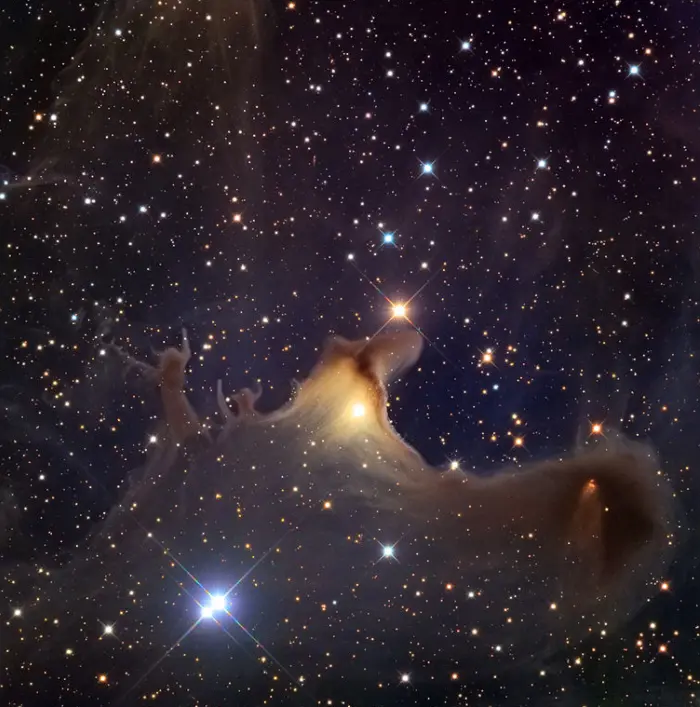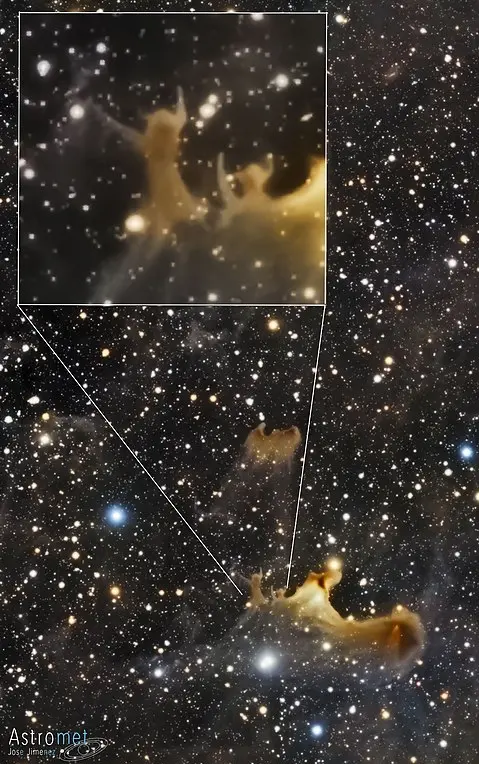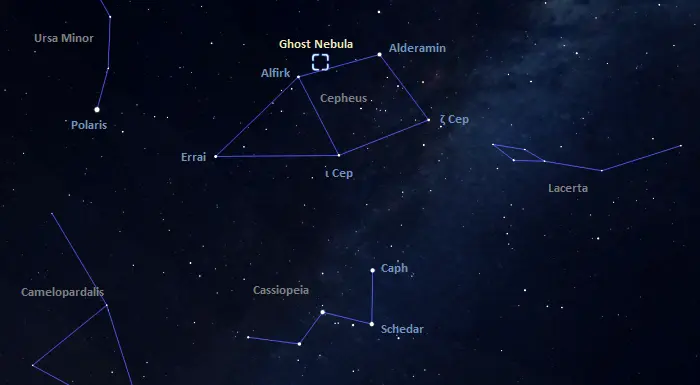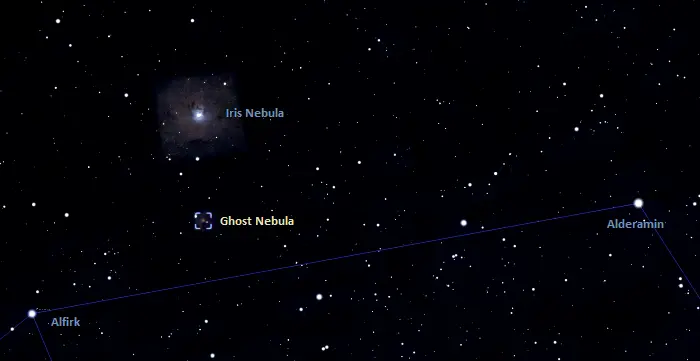The Ghost Nebula is a reflection nebula located approximately 1,470 light-years away in the constellation Cepheus. The nebula’s dust and gas form eerie-looking figures that resemble ghosts as depicted in popular culture. The spooky nebula appears in the same area of the sky as the brighter and larger Iris Nebula (NGC 7023).
The Ghost Nebula spans more than 2 light-years. It is illuminated by several nearby stars. Its spooky appearance has earned it the ghostly nickname. The nebula’s clouds of dust and gas have shapes that resemble human figures with their arms raised. These clouds contain several young stars whose light makes the nebula glow in brownish tones.
The nebula is part of a much larger nebulous region in Cepheus. It lies at the edge of the Cepheus Flare molecular cloud. The Cepheus Flare is a large star-forming region that also encompasses the nearby Iris Nebula. The molecular cloud complex spans an area seven times the size of the full Moon.

Ghost Nebula (Sh2-136), image credit: Adam Block/Mount Lemmon SkyCenter/University of Arizona (CC BY-SA 4.0)
The Ghost Nebula is referred to as a Bok globule, a cloud of cold, dense material with denser knots that can collapse and form new stars. Bok globules typically produce binary and multiple star systems.
The nebula is catalogued as Bok globule CB230. It contains a star that is still in the process of forming. The star’s presence is indicated by cones swirling in opposite directions. The jets of material are carved and sculpted by the wind, ultraviolet radiation, and disk of material swirling around the young star. The class G star embedded within the dust cloud is believed to be a binary star system. It is catalogued as BD+67 1300.

The Ghost Nebula, image credit: José Jiménez (CC BY 2.0)
The Ghost Nebula is one of the several well-known eerie-looking nebulae in the sky. It should not be confused with the Little Ghost Nebula (NGC 6369), a planetary nebula in Ophiuchus, the Ghost of Cassiopeia (IC 63), an emission nebula illuminated by the gigantic star Gamma Cassiopeiae in the constellation Cassiopeia, and the Ghost Head Nebula (NGC 2080) a star-forming region near the larger Tarantula Nebula in the Large Magellanic Cloud in Dorado.
The Ghost Nebula is catalogued as VdB 141 in Dutch-Canadian astronomer Sidney van den Bergh’s Catalog of Reflection Nebulae (1966) and as Sh2-136 in the Sharpless catalogue of H II regions, published by the American astronomer Stewart Sharpless in 1959.
Location
The Ghost Nebula lies in the far northern sky near the brighter Iris Nebula and the variable star Alfirk (Beta Cephei), the third brightest point of light in the constellation Cepheus. Two other nebulae appear in the same area, the dark nebula LDN 1177, and the bright nebula LBN 495.
The constellation figure of Cepheus is a stick house pattern appearing directly above the W of Cassiopeia. The house asterism is formed by five stars easily visible to the unaided eye. Alderamin, the brightest star in Cepheus, is found by extending a line from Schedar through Caph, the rightmost stars of the W. Alfirk is part of the house asterism. It is the brightest star between Alderamin and Polaris in Ursa Minor.

The location of the Ghost Nebula, image: Stellarium
The brighter Iris Nebula lies along the imaginary line extended from Errai, the star at the top of the stick house, through Alfirk, and the Ghost Nebula is located a bit closer to the line connecting Alfirk and Alderamin.

The Ghost Nebula and the Iris Nebula, image: Stellarium
For most observers in the northern hemisphere, the Ghost Nebula is always high above the horizon because it is not too far from the north celestial pole. It never rises for observers south of the latitude 22° S.
The best time of the year to observe the nebula is during the month of November, when Cepheus rises high above the horizon in the evening sky.
Ghost Nebula
| Constellation | Cepheus |
| Diameter | 1,470 light-years |
| Temperature | > 2 light-years |
| Right ascension | 21h 16m 26s |
| Declination | +68° 15.6′ |
| Names and designations | Ghost Nebula, Sharpless 2-136, Sh2-136, VdB 141 |